Maqbool Fida Husain (Indian, 1915-2011)Untitled (Horses)
signed 'Husain' lower left, circa early 1990s
acrylic on canvas, framed
100.8 x 74.5cm (39 11/16 x 29 5/16in).FootnotesProvenance
Property from a private collection, London.
Acquired from the artist in the late 2000s.
Animals and birds have appeared in Indian sculpture since ancient times. In painting, apart from the pre-historic rock paintings in which there is naturally a strong presence of animals, the practise of incorporating animal and bird forms is an uninterrupted tradition right up to contemporary times. Quite often, these creatures reflect or enhance the mood of the human characters in the painting with their emotional, literary and mythical associations or just represent nature along with its other elements.
Husain is an inheritor of this classical and folk tradition that he reformulates for his own purpose as a modern artist...One of his most perennial obsessions as an artist has been the form of the horse. During an interview with the well known art critic Vinod Bhardwaj in 1979, Husain said, I say this about myself: I sell horses and make films....Husain's encounter with horses began in his childhood in Indore. These encounters came in several forms with different associations, inspiring different emotions...
One of the closest friends of his grandfather Abdul was Acchan Mian. He was a farrier. Husain would often accompany his grandfather when he visited Acchan Mian's workshop. At the time, tonga or a horse drawn carriage was a common mode of transport in Indore. Tonga horses were often brought to Acchan Mian's workshop for fixing iron shoes. At this stage the dominant emotion that was associated with the horse in Husain's mind was that of a friendly, gentle and affectionate animal that helped poor men earn their daily living. Acchan Mian's workshop also sometimes attracted horses from the local Holkar King's cavalry and the fancy carriages of British officers who represented a kind of imported royalty. These animals exuded an aura of dignity, power, speed, vitality and aristocratic elegance...
Another major source for Husain's horses is the iconic Duldul, Imam Husain's horse in the battle of Karbala, whose decorated image was carried during the Muharram processions in Indore that Husain had often watched in his boyhood. The iconic image of Duldul is a large toy like image in a rising posture with front legs stretched out...
This folk-heroic form of Duldul became more complex when Husain entered Bombay's art world and started travelling to different parts of India. During these travels, he became aware of several other traditional forms of the horse in folk arts and crafts. One of these forms is the unique Bankura horse or West Bengal that has a distinctive elongated and erect neck, and raised ears...
Husain similarly reaches out to other ritualistic and mythical sources of the horse such as the horses in the Chariot of the Sun God in the Konark temple and Ashvamedha that was the standard bearer of an emperor who wanted his supremacy to be acknowledged by smaller kings and chieftains...
Apart from these diverse Indian sources Husain has also been influenced by some foreign sources in evolving his unique horses. According to Shiv S. Kapur, during Husain's visit to China in 1952, He studied the Sung dynasty renderings of horses. In addition, Husain also specifically acknowledges his debt to the horses of Xu Beihong... Husain's horses that show Chinese influence generally have flying manes, prancing movement, open jaws and flared nostrils. They exude a feeling of vitality, vigour, anger and aggression. (K. Bikram Singh, Maqbool Fida Husain, New Delhi, 2008, p.169-176).
The three horses depicted in Untitled (Horses) illustrate a cohesion of the various influences on Husain. Painted in a vibrant red, the colour of the Bankura horse, gold, the colour of Chinese horses and white, the colour of Duldul, their bodies dominate the painting, whilst creating a balance and harmony at the same time. We can see the front legs, neck and head of the red horse, the body and neck of the gold horse and the full body of the white horse. They appear to be surging forth from the canvas, converging and prancing and have the characteristic open jaws, flared nostrils and an absence of hooves, exuding energy, passion, purity and earthly qualities. Painted using quick brushstrokes, their forms have been created entirely in colour, without a dependence on line and resemble puppets or wooden effigies. The background heightens the atmosphere, with shades of deep maroons and purple merging seamlessly. The painting is a testament to Husain's multifaceted understanding and appreciation of cultures, fusing tradition and modernity, symbolism and vitality, in a singular work of art.
Maqbool Fida Husain (Indian, 1915-2011)Untitled (Horses)
signed 'Husain' lower left, circa early 1990s
acrylic on canvas, framed
100.8 x 74.5cm (39 11/16 x 29 5/16in).FootnotesProvenance
Property from a private collection, London.
Acquired from the artist in the late 2000s.
Animals and birds have appeared in Indian sculpture since ancient times. In painting, apart from the pre-historic rock paintings in which there is naturally a strong presence of animals, the practise of incorporating animal and bird forms is an uninterrupted tradition right up to contemporary times. Quite often, these creatures reflect or enhance the mood of the human characters in the painting with their emotional, literary and mythical associations or just represent nature along with its other elements.
Husain is an inheritor of this classical and folk tradition that he reformulates for his own purpose as a modern artist...One of his most perennial obsessions as an artist has been the form of the horse. During an interview with the well known art critic Vinod Bhardwaj in 1979, Husain said, I say this about myself: I sell horses and make films....Husain's encounter with horses began in his childhood in Indore. These encounters came in several forms with different associations, inspiring different emotions...
One of the closest friends of his grandfather Abdul was Acchan Mian. He was a farrier. Husain would often accompany his grandfather when he visited Acchan Mian's workshop. At the time, tonga or a horse drawn carriage was a common mode of transport in Indore. Tonga horses were often brought to Acchan Mian's workshop for fixing iron shoes. At this stage the dominant emotion that was associated with the horse in Husain's mind was that of a friendly, gentle and affectionate animal that helped poor men earn their daily living. Acchan Mian's workshop also sometimes attracted horses from the local Holkar King's cavalry and the fancy carriages of British officers who represented a kind of imported royalty. These animals exuded an aura of dignity, power, speed, vitality and aristocratic elegance...
Another major source for Husain's horses is the iconic Duldul, Imam Husain's horse in the battle of Karbala, whose decorated image was carried during the Muharram processions in Indore that Husain had often watched in his boyhood. The iconic image of Duldul is a large toy like image in a rising posture with front legs stretched out...
This folk-heroic form of Duldul became more complex when Husain entered Bombay's art world and started travelling to different parts of India. During these travels, he became aware of several other traditional forms of the horse in folk arts and crafts. One of these forms is the unique Bankura horse or West Bengal that has a distinctive elongated and erect neck, and raised ears...
Husain similarly reaches out to other ritualistic and mythical sources of the horse such as the horses in the Chariot of the Sun God in the Konark temple and Ashvamedha that was the standard bearer of an emperor who wanted his supremacy to be acknowledged by smaller kings and chieftains...
Apart from these diverse Indian sources Husain has also been influenced by some foreign sources in evolving his unique horses. According to Shiv S. Kapur, during Husain's visit to China in 1952, He studied the Sung dynasty renderings of horses. In addition, Husain also specifically acknowledges his debt to the horses of Xu Beihong... Husain's horses that show Chinese influence generally have flying manes, prancing movement, open jaws and flared nostrils. They exude a feeling of vitality, vigour, anger and aggression. (K. Bikram Singh, Maqbool Fida Husain, New Delhi, 2008, p.169-176).
The three horses depicted in Untitled (Horses) illustrate a cohesion of the various influences on Husain. Painted in a vibrant red, the colour of the Bankura horse, gold, the colour of Chinese horses and white, the colour of Duldul, their bodies dominate the painting, whilst creating a balance and harmony at the same time. We can see the front legs, neck and head of the red horse, the body and neck of the gold horse and the full body of the white horse. They appear to be surging forth from the canvas, converging and prancing and have the characteristic open jaws, flared nostrils and an absence of hooves, exuding energy, passion, purity and earthly qualities. Painted using quick brushstrokes, their forms have been created entirely in colour, without a dependence on line and resemble puppets or wooden effigies. The background heightens the atmosphere, with shades of deep maroons and purple merging seamlessly. The painting is a testament to Husain's multifaceted understanding and appreciation of cultures, fusing tradition and modernity, symbolism and vitality, in a singular work of art.
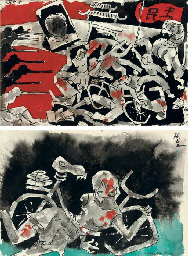
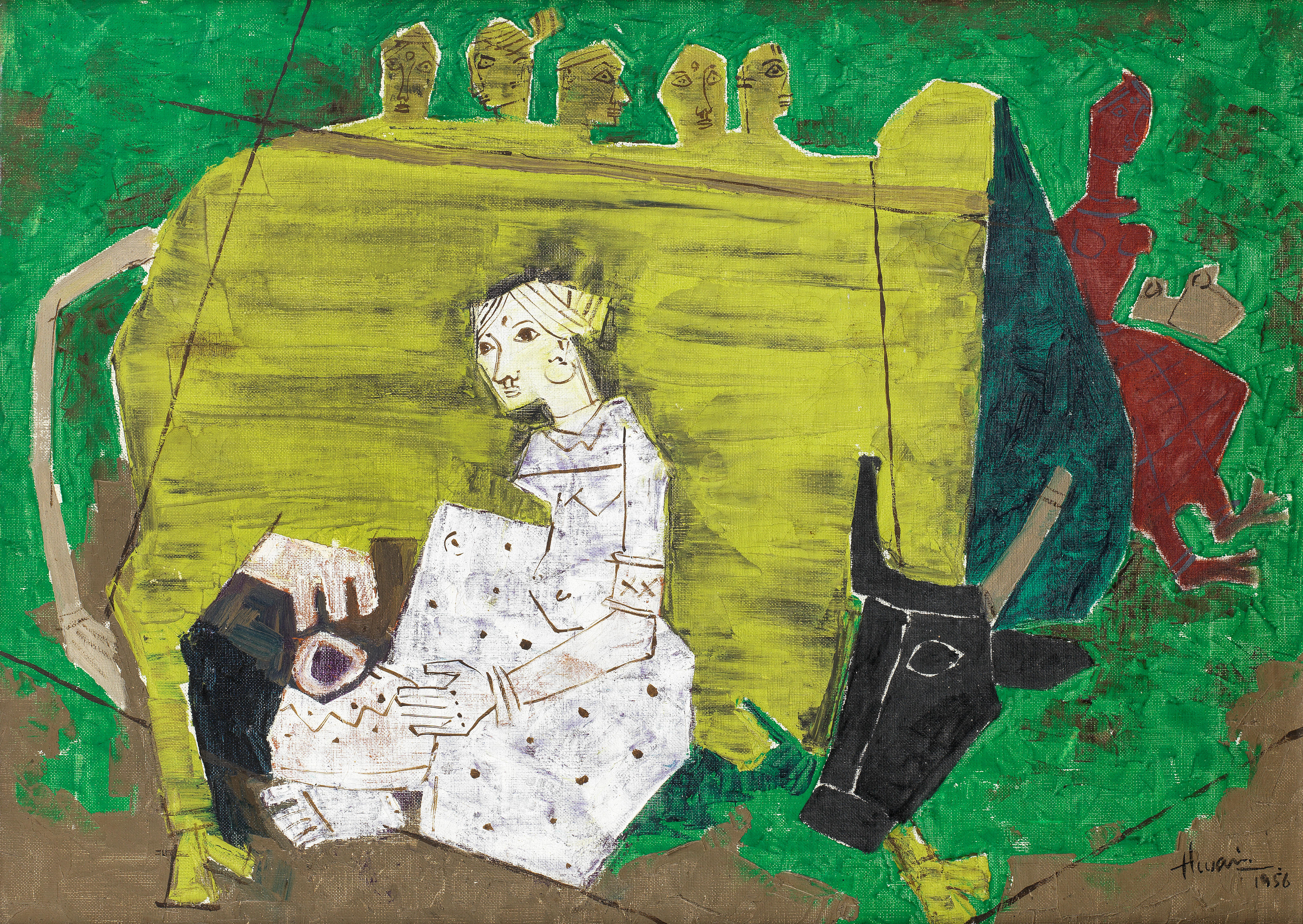
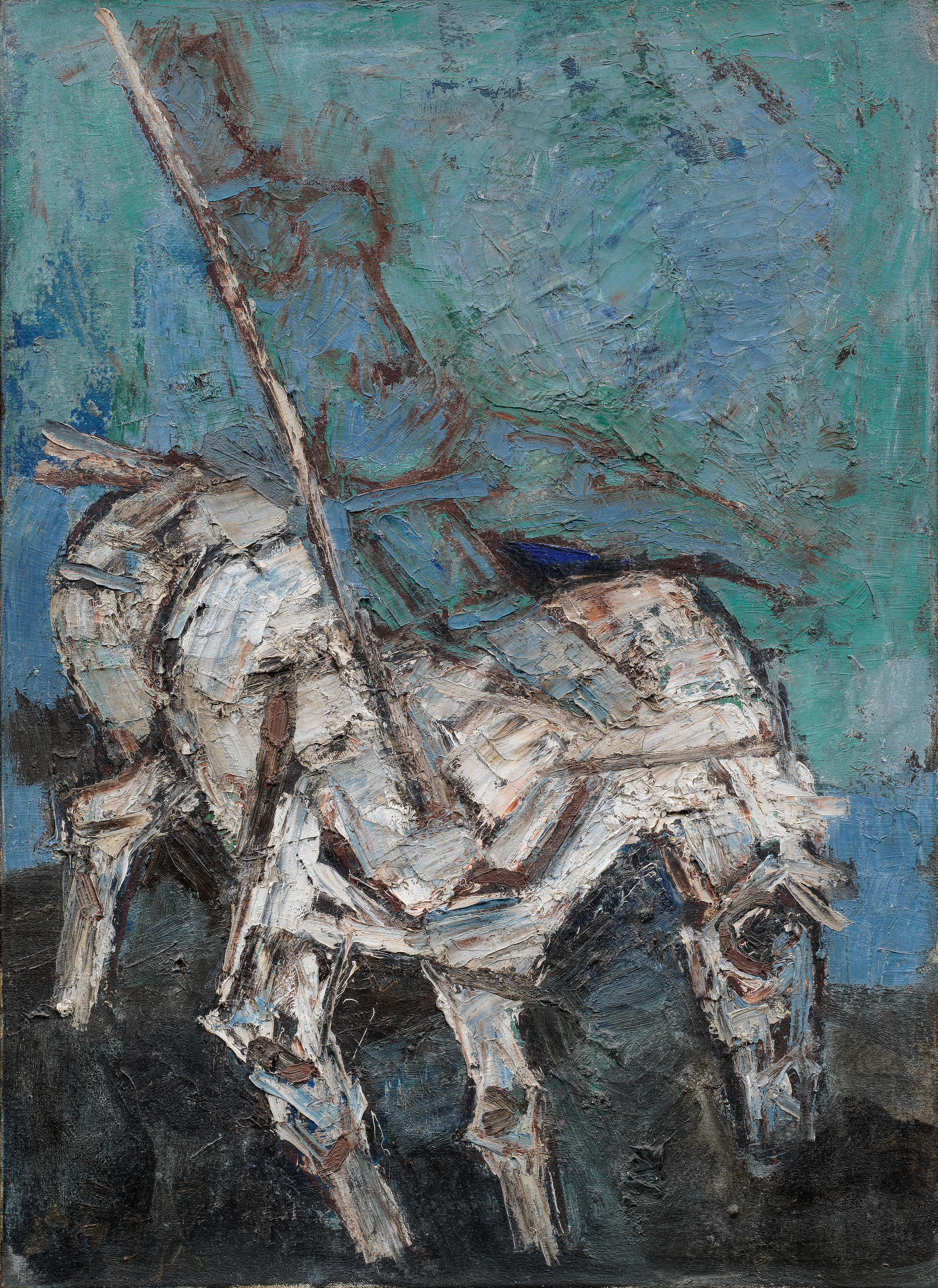
.jpg)
.jpg)
.jpg)
.jpg)
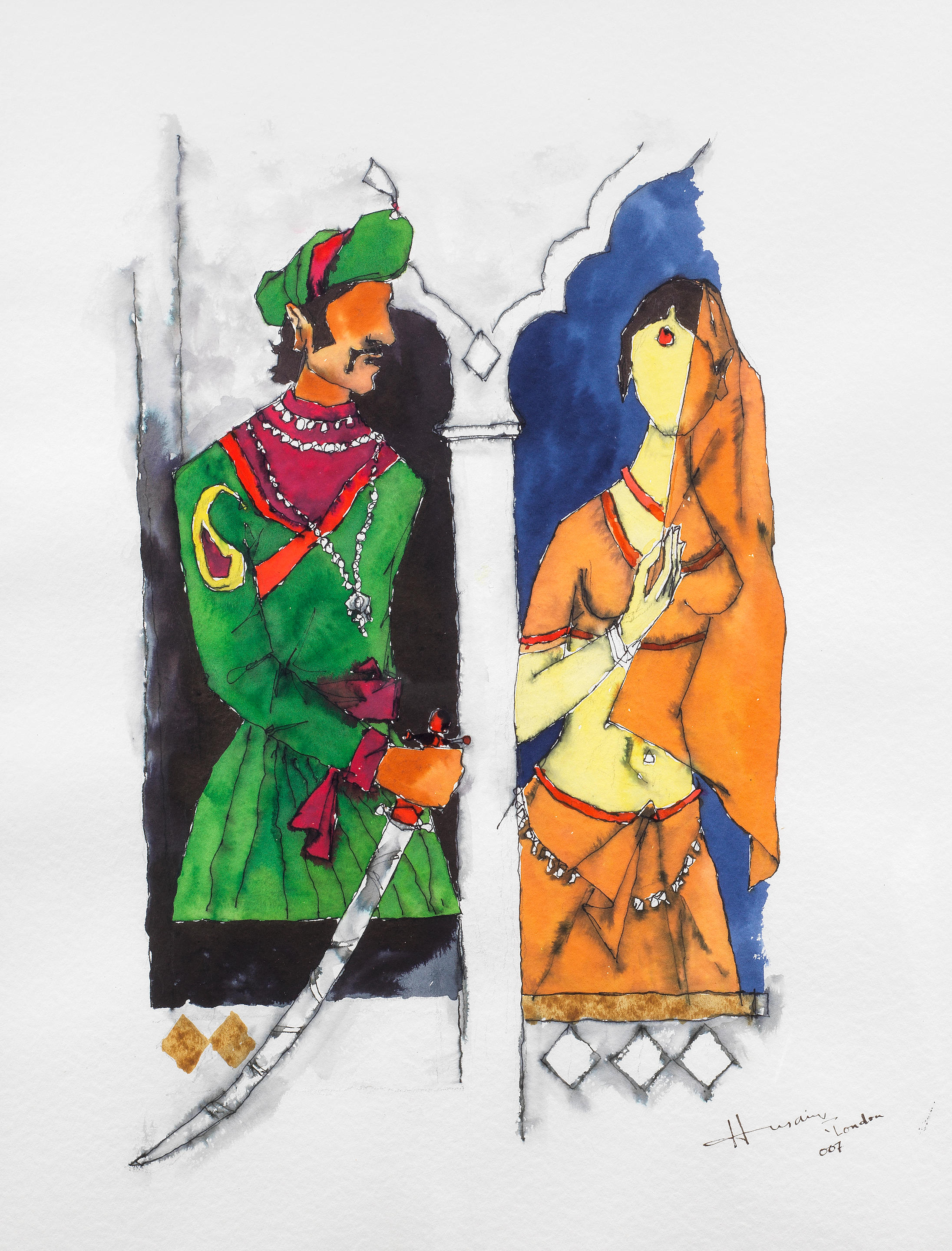
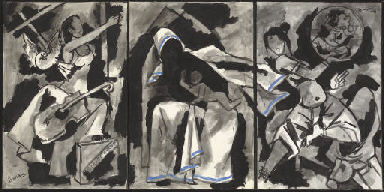
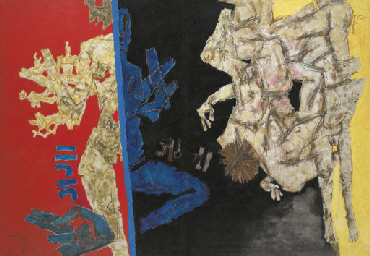
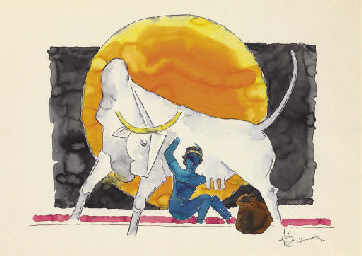
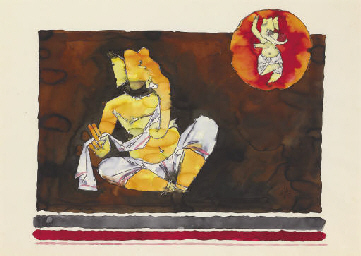
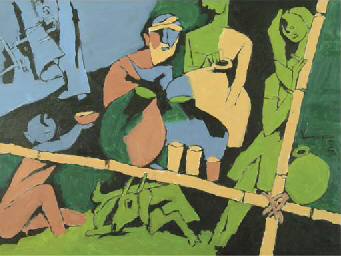
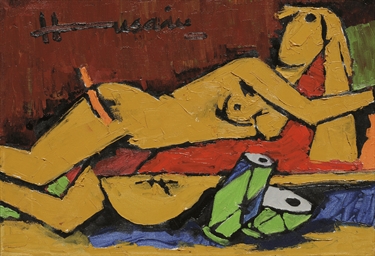
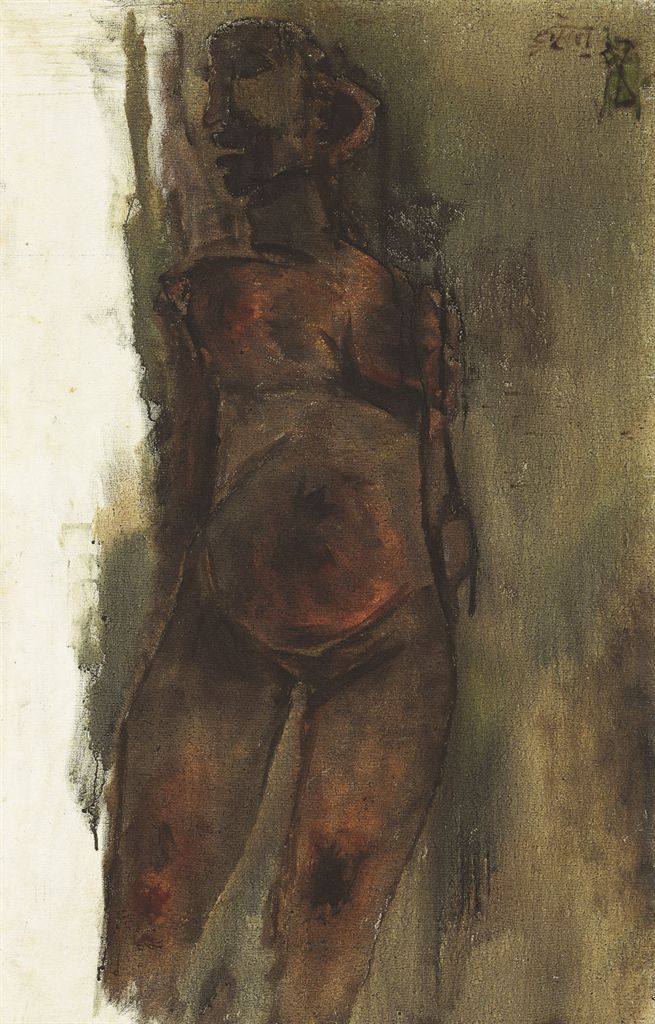
Testen Sie LotSearch und seine Premium-Features 7 Tage - ohne Kosten!
Lassen Sie sich automatisch über neue Objekte in kommenden Auktionen benachrichtigen.
Suchauftrag anlegen